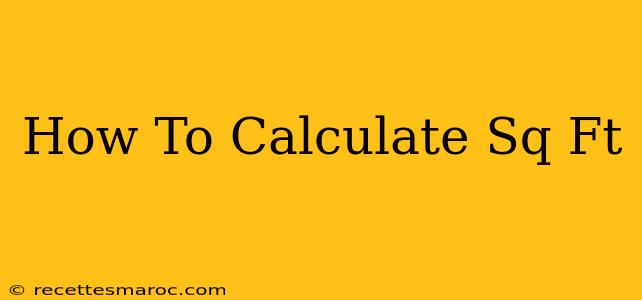Calculating square footage is a fundamental skill with applications ranging from home improvement projects to real estate transactions. Understanding how to accurately determine square footage is crucial for various reasons, from determining material needs for a renovation to assessing the value of a property. This comprehensive guide will walk you through the process, covering different shapes and scenarios.
Understanding Square Footage
Square footage (sq ft) refers to the area of a space, measured in square feet. One square foot is a square with sides measuring one foot each. Calculating square footage is essentially finding the total area covered by a space. This measurement is vital for various purposes, including:
- Home renovations and improvements: Determining the amount of flooring, paint, or tiles needed.
- Real estate: Assessing property value and comparing the size of different properties.
- Construction: Planning building layouts and material requirements.
- Landscaping: Calculating the amount of grass seed, fertilizer, or paving stones needed.
Calculating Square Footage for Common Shapes
The method for calculating square footage depends on the shape of the area you're measuring. Here's how to calculate it for common shapes:
1. Rectangles and Squares:
This is the simplest calculation. For rectangles and squares, the formula is:
Area = Length x Width
- Length: Measure the longest side of the rectangle or square in feet.
- Width: Measure the shortest side of the rectangle or square in feet.
- Multiply the length and width to get the square footage.
Example: A room measuring 12 feet long and 10 feet wide has a square footage of 12 ft x 10 ft = 120 sq ft.
2. Triangles:
For triangles, the formula is slightly different:
Area = (1/2) x Base x Height
- Base: Measure the base of the triangle in feet.
- Height: Measure the height of the triangle (perpendicular to the base) in feet.
- Multiply the base and height, then divide the result by 2.
Example: A triangle with a base of 8 feet and a height of 6 feet has an area of (1/2) x 8 ft x 6 ft = 24 sq ft.
3. Circles:
The formula for calculating the area of a circle is:
Area = π x r²
- π (pi): Use 3.14159 as an approximation for pi.
- r (radius): Measure the radius of the circle (the distance from the center to the edge) in feet.
- Square the radius (multiply it by itself), then multiply the result by pi.
Example: A circle with a radius of 5 feet has an area of 3.14159 x 5 ft x 5 ft ≈ 78.54 sq ft.
Calculating Square Footage for Irregular Shapes
Calculating the square footage of irregularly shaped areas requires a more nuanced approach. Here are a few methods:
1. Dividing into Smaller Shapes:
Break down the irregular shape into smaller, more manageable shapes (rectangles, triangles, etc.). Calculate the area of each smaller shape individually, and then add the areas together to get the total square footage.
2. Using Grid Method:
Overlay a grid (drawn on paper or using software) over the irregular shape. Count the number of squares completely within the shape and estimate the area of partially covered squares. The more precise your grid, the more accurate your result will be.
Important Considerations
- Measurements: Use a measuring tape to get accurate measurements. Measure in feet.
- Units: Ensure all your measurements are in the same units (feet) before calculating.
- Accuracy: While estimations are sometimes necessary, strive for the most accurate measurements possible, especially for important projects.
- Obstacles: When measuring rooms, account for any permanent fixtures (like built-in cabinets) that reduce the usable floor space. Subtract these areas from the total.
By following these methods, you can confidently calculate square footage for various applications. Remember to always double-check your measurements and calculations to ensure accuracy. Mastering this skill will save you time, money, and potential headaches in your future projects.

